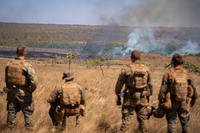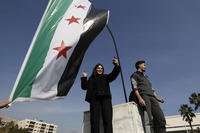KAJAKI, Afghanistan — The Marines of 2nd Battalion, 5th Marine Regiment added to their rich history when they trekked through Zamindawar, one of the few remaining insurgent strongholds in Afghanistan, May 26-June 9 to disrupt the insurgents’ leadership and logistics chain.
For 15 days Marines engaged the insurgents in and around the town located within the Kajaki district, taking small arms fire, mortars and rocket-propelled grenades, as the enemy attempted to repel their attack.
The importance of the operation wasn’t lost on the Marines.
“If this is one of their strongholds, and we came in and cleared the area the way we did, especially with no (combat-related) casualties, that’s a success in our book,” said Staff Sgt. John Wildman, a platoon sergeant with Golf Company, 2nd Bn., 5th Marines. “I believe people will talk about (the operation). We definitely made an impact.”
The Marines targeted Zamindawar because of the strong insurgent presence, hoping to disrupt the leadership and logistics chain of the enemy.
“We definitely eliminated some of their key figures – high value individuals as we like to call them,” said 1st Lt. Benjamin Royal, a platoon commander with Golf Co.
Marines eliminated more than 50 enemy insurgents during the operation, destroyed numerous fighting positions, all without any civilian or Marine combat related casualties.
“You can definitely tell the (insurgents) are worried and confused,” said Royal, a native of Clinton Township, N.J. “They held numerous meetings trying to figure out what to do with the Americans.”
The Marines kept the insurgents guessing by using their superior night vision to move under the cover of darkness and employing M1A1 Abram Main Battle Tanks.
“The tanks came in and completely changed the landscape of the battlefield,” said Lance Cpl. Geoffrey West, a machinegunner with the battalion.
Alpha Company, 1st Tank Battalion supported the Marines throughout the operation, eliminating insurgents and destroying fighting positions.
West, a native of Los Angeles, added at times it seemed the enemy didn’t know how to react to the tank’s superior armor and accurate firing.
In one example, a tank took a direct hit from a rocket-propelled grenade. It briefly stunned the crew but otherwise the damage was minimal and they returned fire, eliminating the enemy.
The enemies used bunkers and an intricate karez system to attack the Marines. A karez system is a complex collection of connecting, underground waterways, allowing the insurgents to move around unseen.
Insurgents also used children to relay messages, often walking between them and the Marines in an attempt to gain any advantage.
“We spotted children watching us as well as being used as distractions before attacks,” said Lance Cpl. Jeremy Corea, an assaultman with the battalion and a native of Elk Grove, Calif. “It’s hard because we know they are being used against us, but what are you going to do? You can’t shoot (civilians).”
The Marines also battled the elements, patrolling and maintaining security in temperatures rising above 120 degrees Fahrenheit.
“The heat is something that’s new to us,” said Royal. “The first couple days were like 95 (degrees Fahrenheit) and by the end it (had) reached in excess of 120.”
The heat, combined with anywhere from 70 to 100 pounds of gear, meant staying hydrated was a priority. Daily resupplies of water became a necessity.
“The (Marines) faced a lot of challenges with the heat, but they’re Marines and (they) kept doing their job,” said Wildman, a native of Laurel, Miss.
The Marines’ objective extended beyond clearing an area in Kajaki. They helped disrupt the insurgent leadership structure, benefiting the Afghan National Security Forces.
“The biggest thing (the Marines) have to take away is setting up the Afghan Army and Afghan Police for when we leave here,” said Royal. “We are helping the Afghans and easing their transition after we leave.”
The area, which previously saw few coalition forces, will have Afghan forces conducting their own patrols, as the Marines begin to transition from combat operations to advising the ANSF.
After 15 days of firefights and mortar rounds the Marines left the town of Zamindawar ready for hot food and a warm shower.
“We accomplished a lot,” said Royal. “This was one of the final, largest operations that was U.S. led. I think anyone who was in Afghanistan during this time period is going to know about Operation Jaws and they’re going to know what happened in Zamindawar.”
The Marines of 2nd Bn., 5th Marines, continued adding to their battalion’s rich history, writing Zamindawar into the unit’s history books.
“For most of our guys this was their first combat deployment and none of them knew what to expect, but they came here and did what they had to do,” said Wildman. “I can’t say that enough about our guys. They do what we ask and they do it well.”























